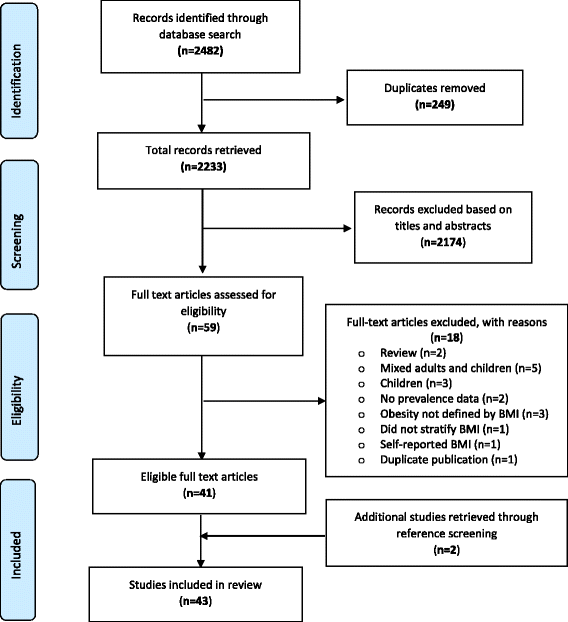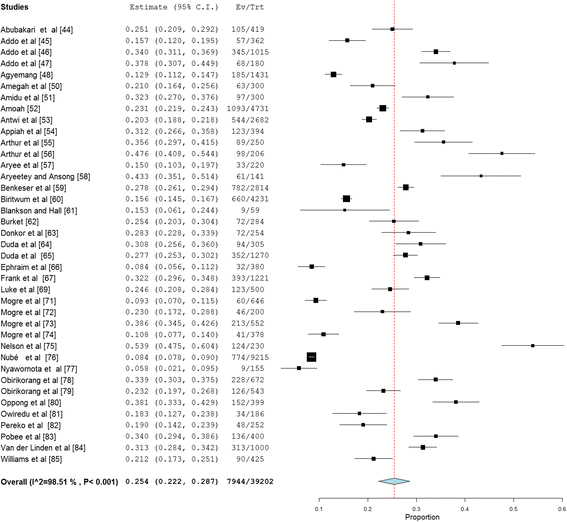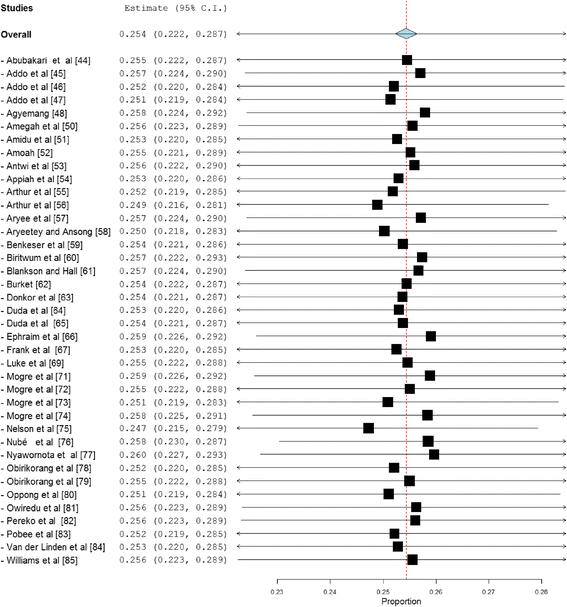Overweight and obesity epidemic in Ghana-a systematic review and meta-analysis
- PMID: 27938360
- PMCID: PMC5148846
- DOI: 10.1186/s12889-016-3901-4
Overweight and obesity epidemic in Ghana-a systematic review and meta-analysis
Abstract
Background: In many low and middle income countries (LMICs), the distribution of adulthood nutritional imbalance is shifting from a predominance of undernutrition to overnutrition. This complex problem poses a huge challenge to governments, non-state actors, and individuals desirous of addressing the problem of malnutrition in LMICs. The objective of this study was to systematically review the literature towards providing an estimate of the prevalence of overweight and obesity among adult Ghanaians.
Methods: This study followed the recommendations outlined in the PRISMA statement. Searches were performed in PubMed, Science Direct, google scholar, Africa Journals Online (AJOL) and the WHO African Index Medicus database. This retrieved studies (published up to 31st March 2016) that reported overweight and obesity prevalence among Ghanaians. All online searches were supplemented by reference screening of retrieved papers to identify additional studies.
Results: Forty-three (43) studies involving a total population of 48,966 sampled across all the ten (10) regions of Ghana were selected for the review. Our analysis indicates that nearly 43% of Ghanaian adults are either overweight or obese. The national prevalence of overweight and obesity were estimated as 25.4% (95% CI 22.2-28.7%) and 17.1% (95% CI = 14.7-19.5%), respectively. Higher prevalence of overweight (27.2% vs 16.7%) and obesity (20.6% vs 8.0%) were estimated for urban than rural dwellers. Prevalence of overweight (27.8% vs 21.8%) and obesity (21.9% vs 6.0%) were also significantly higher in women than men. About 45.6% of adult diabetes patients in Ghana are either overweight or obese. At the regional level, about 43.4%, 36.9%, 32.4% and 55.2% of residents in Ashanti, Central, Northern and Greater Accra region, respectively are overweight or obese. These patterns generally mimic the levels of urbanization. Per studies' publication years, consistent increases in overweight and obesity prevalence were observed in Ghana in the period 1998-2016.
Conclusions: There is a high and rising prevalence of overweight and obesity among Ghanaian adults. The possible implications on current and future population health, burden of chronic diseases, health care spending and broader economy could be enormous for a country still battling many infectious and parasitic diseases. Public health preventive measures that are appropriate for the Ghanaian context, culturally sensitive, cost-effective and sustainable are urgently needed to tackle this epidemic.
Keywords: Ghana; Meta-analysis; Non-communicable diseases; Nutrition transition; Obesity.
Figures









References
Publication types
MeSH terms
LinkOut - more resources
Full Text Sources
Other Literature Sources
Medical

